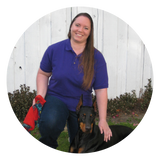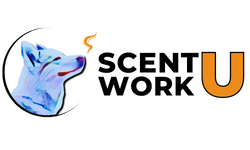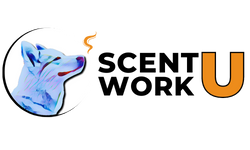Strive for Clarity

Have you ever had someone ask you do something, and you quite literally had no idea whatsoever what they were talking about? It was as if they uttered half completed sentences, the majority of which were stuck in their own head? Something along the lines of, “…then you will go and … yeah. Okay? Go do that.”
You stare at them bewildered. They look back at you as if to say, “…and you are waiting for what, exactly? Go do it!” You BOTH start getting frustrated. They don’t know why you are not doing the thing and you haven’t the slightest idea what the “thing” is.
It is enough to get your blood pressure rising, isn’t it?!
The same confusion, or garbling of a message, happens in dog training all-of-the-time. Scent Work is no exception. This confusion certainly occurs between dog handlers and their dogs, but also between instructors and their students.
We must strive for clarity, to avoid this quagmire of confusion.
CLARITY FROM HANDLER TO DOG
First off, you need to know what it is you want to convey. What do you want your dog to DO? Notice it must be a thing they can DO, not NOT do. For instance, it is not particularly helpful to say, “I want my dog to NOT mess with the distractors in a search.” Instead, you would reframe that to, “I want my dog to find their hides even when distractors are present.”
“What’s the difference?”
It is all about where you are placing your emphasis and creating clarity in your own mind. We WANT our dogs to find the HIDES, NOT the distractors. If that is our intent, we can design incrementally progressive searches that promote this.
Juxtapose that against a set-up where we are placing all our focus ON the distractors themselves. In this scenario, the hides get lost in the picture.

Essentially, when we focus solely on the distractors, we create a scenario where the distractors are a major beacon of light calling out to the dog. The exact OPPOSITE of what we want!
![]()
“Oh…”
Interesting, right? Hence why striving for clarity is so important. It can prevent us from creating more problems for ourselves! If our dog ran these searches a number of times, and every time they self-rewarded on the pizza distractors, what do we think they are learning? Certainly NOT that finding their hide is part of the game!
Alright, having a solid understanding of what we want our dog to do is paramount. The second piece of the puzzle is thinking through HOW to design a training exercise that gets you closer to achieving this goal.
Using our distractor example again, if the goal is for the dog to find the hide when distractors are present, wouldn’t you want the hide to be front-and-center, with the distractors barely even part of the equation, at least to begin with?
![]()
As the dog successfully tackles these types of searches, finding their hides and paying the distractor no mind, you could move the distractor closer-and-closer, or even increase the level of the distractor.


The point is, thoughtfully designing your search will ensure you are being clear as to the objective to the dog: find the hide and pay the distractors no mind. Numerous successful repetitions cement to the dog that finding the hide is the goal. Finding the hide WORKS. Messing with the distractor is not even worth thinking about.
The final piece of the puzzle of providing clarity in training is what YOU do when you are running this exercise. What are you doing handling-wise? When are you rewarding? How are you rewarding? All this feedback to your dog makes a huge difference!
Using our distractor example again, if your dog successfully dove into a search area, bypassed all the distractors, and immediately hit upon their hide and you simply just stood there, what message are you sending to the dog? Worst still, if you did move into reward, but you were DISAPPOINTED because they found it so fast, “UGH, I guess this was too easy!”, what is your dog supposed to take away from that?!
They FOUND their hide SUPER quickly and DID NOT mess with the distractors…yet you are disappointed and providing them with that feedback. So, finding the hide is not what you want, apparently? YIKES!
If your dog did this amazingly fast and efficient type of search at a trial, you would be beyond thrilled and would likely have earned a placement as a result. Then why on earth are you disappointed in training?!
Yet time and time again, handlers make these choices that muddy the picture for their dog. The dog THOUGHT they understood what the goal was, what they needed to do to earn their goodies, yet when they do those things, their handler doesn’t respond in a way that supports this. Or, if the handler does respond, it is slow and confusing. The handler may not even reward the dog at all! What is the dog supposed to think!?
This lack of clarity of how we conduct ourselves as handlers when running a search, in training or at trial, causes a cloud of confusion to form over the entire search. It invites the dog to re-think what is being asked of them. Remember: dogs do what works. If finding the hide didn’t work, maybe they need to try something else.
For instance, when working with distractors, the dog may think, “Finding the hide didn’t work…maybe the two-legged person wants me to sniff this Tupperware container that has pizza in it? I don’t know…”
This all boils down to taking responsibility as a TEACHER. Your learner, in this case your dog, is depending on you to properly TEACH them. If they are confused, that is not the dog’s fault. That responsibility rests squarely on our shoulders.
Thus, try to provide as much clarity as possible and if the dog is confused, try to determine where the message became garbled, clean it up and breakdown the exercise into smaller pieces to help it make more sense.
CLARITY FROM INSTRUCTOR TO STUDENT
This may be a hard pill for my fellow colleagues to swallow, but when a human student is struggling, nine times out of ten, it is your fault.
“BUT THEY DIDN’T LISTEN!”
Are you sure they didn’t just misunderstand?
“I SAID IT 5 DIFFERENT TIMES!”
But did you try saying it 5 different WAYS?
“THEY JUST DO WHAT THEY WANT!”
Or, maybe, they are looking for ways to make it “work” for them, just like the dog would.
“UGH!”
Being an instructor is hard. There is no doubt about it. You must take the knowledge you have, figure out what pieces will apply to this dog, this handler, this TEAM, and explain it in a way that the HANDLER can understand and then TRANSLATE to their dog. Rather tricky if you ask me.
Once again, using clarity can help.
Remembering that what is second nature to us as instructors may have to be explicitly laid out to your students. For instance, with your years of experience, you simply “know” when to step-in to reward, how to get your treats out and feed them to the dog, one right after another, without dropping any treats on the ground, and how to go about opening a lane for the dog to continue searching within the space.
Just stop for a moment and think through all the skills this sequence involves: properly reading the dog, determining what you are rewarding for, timing skills, mechanical skills (gathering the treats, holding them in your hand, successfully feeding the dog without dropping any) and the body language awareness to not interfere with the dog.
So, when you tell your student, “Go in and reward your dog” and they are a bumbling mess the first few times, it really should not be all that surprising!
“I don’t have enough time in class to break all this down. People are mad as it is, they do not feel as though they get enough searches in!”
Teaching in-person training classes, even working with clients privately, is challenging. There is no denying this. Balancing expectations with time limitations, figuring out what you absolutely must cover and what may have to be sacrificed to the cutting floor due to time is a very real thing.
However, the fact remains: your clients NEED these fundamental skills, and they will not learn them magically on their own. Or if they try, they may develop nasty habits that will be a million times harder to break later.
So, what can you do? How can we leverage the need for clarity to come up with a solution?
Again, think through what you want your human client to DO.
Perhaps you can do handler-only exercises in the middle of the class to give the dogs a much-needed break. Do a drill or two that pairs people up, one playing the role of handler and the other playing the role of dog, then swapping. Make it a fun game that invites people to loosen up and laugh. Even do a Simon Says sort of thing, to help them visualize and mechanically practice some of these skills, such as getting their treats out of their treat pouch, holding a few in their hand at once and delivering one treat at a time without dropping any as the "dog" holds onto a cup to put the treats into.
You can do the same sort of thing when it come to reading the dog, learning body awareness, social pressure, leash and long line handling skills, mental management techniques, coping with stress...all the skills a human handler needs to be a good teammate to their dog.
When you devise these solutions, ensure you are covering all the various types of learners: those who learn best by watching, those who learn best by doing, those who learn best by listening and those who learn best by reading.
Provide short handouts students can read at home or short videos they can watch on their own. Identify all the ways to help cement the ideal picture of what they need to do in their own mind.
Essentially, your human clients must first LEARN these skills before they can ever hope to properly TEACH their dog.
The only way this is going to be possible is if you provide as much clarity as possible. Break things down the same exact way as you would for your canine clients. Simply being the same species as your human client and speaking the same language is not enough. You must find ways to bridge the gap between what you know and what they need to know.
Be patient and take ownership when things do not go well. Should you notice things are going left, this doesn’t mean you are bad instructor. It means you need to devise a clearer and different way to reach THIS client and THEIR needs. If you ignored that your approach was not working and continued stubbornly along that path to the detriment of your client and their dog, THAT would make you a bad instructor. Don’t do that.
FINAL THOUGHTS
It may sound obvious that we need to be clear when training our dogs, or working with our clients as instructors, but it can be harder than it sounds. Providing clarity means we must stop and truly think through: what are we trying to achieve? How will the learner receive this information? How could it be misconstrued? What fallout is possible? Am I baking in more problems by doing it this way? Am I needlessly sacrificing other essential skills? Am I progressing too fast, too slow or staying stagnant?
We must also be ready to stop and adjust our approach if the results are not what we intended. Forward progression is NOT guaranteed, quite the opposite. It is entirely possible you will go BACKWARDS if you are not careful.
Therefore, strive for clarity whenever you are training your dog or working with your clients. It may take some extra legwork, planning and thinking, even admitting when things are not working out as you intended, but you, your dog and your clients will benefit greatly from it in the end.

Dianna has been training dogs professionally since 2011. She has done everything from teaching group training classes and private lessons, to specializing in working with fearful, reactive and aggressive dogs, to being a trial official and competition organization staff member.
Following a serious neck and back injury, Dianna was forced to retire from in-person dog training. But she was not ready to give up her passion! So, she created Pet Dog U and Scent Work University to provide outstanding online dog training to as many dog handlers, owners and trainers possible…regardless of where they live! Dianna is incredibly grateful to the amazingly talented group of instructors who have joined PDU and SWU and she looks forward to the continued growth of PDU and SWU and increased learning opportunities all of these online dog training platforms can provide.
In June 2021, Dianna and her business partner, Sean McMurray launched Cyber Scent Work, Inc., an organization that operates in the gray space between training and trialing in Scent Work. With Cyber Scent Work, Inc., handlers have the opportunity to earn Qs, titles and ribbons while also receiving helpful training advice regardless of whether they qualify or not! Be sure to check out Cyber Scent Work, Inc., you will be happy you did!
Join Our Newsletter
Stay up to date with all the happenings at Scent Work University, including the release of new online courses, seminars, webinars, eBooks and receive exclusive promotions and discounts!


